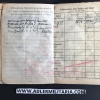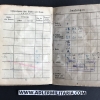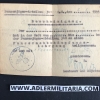Description
Friederich Maaßen was born in Habinghorst in 1921.
His Soldbuch was issued in January of 1942 with an infantry training regiment.
He served with:
Infanterie Regiment 696 – 13th I.G. Kp ( 340 Infantry Division)
Serving in the Infantry Support Gun Company:
With the loading of the first parts of the division onto the railroad, on May 12, 1942, the transfer to the east began with unloading in Volkowysk. For the most part, they reached the Dnieper in the Gomel area via Baranowicze – Ssluzk – Rogachev, mostly by land march. Here the division was briefly assigned to security services and also took part in a partisan operation. After a further land march via Chernigov – Neshin – Baturin – Glukhov, the division arrived in Kursk with the last parts on July 4, 1942, and then in a brisk advance south of the Kursk-Kastornoje railway line with the first parts on July 5th the area between the rivers Kschen and reach Olympus. During the march, smaller, scattered enemy groups were attacked again and again, but this did not cost us any casualties. By July 7, the division was assembled in bulk in the Kastornoye area (here DivGefStd). Despite the strenuous marches of the past, the division began the following day to relieve the 9th Panzer Division northeast of Kastornoje and took up a position northwest of Voronezh in line with the right wing at Gremjatsche/Malaya Werejka – Spasskoje – Ilinowka – Golossnowka. On July 10 (first battle!) they came under a strong enemy tank attack, which led to a break-in 2 km east of Maloprokrowka as far as Wereika (north of Semljansk). Here the division was in very hard defensive fighting (killing 10 tanks) and was supported by the Luftwaffe. This burglary was then cleared on July 13 by surrounding the enemy together with armored forces from the 9th PD. The enemy had assembled in front of the divisional front with strong armored forces (over 100 tanks), heavy artillery and motorized infantry and attacked the division several times a day for the next two weeks. All attacks were repelled (partly in counterattacks) and the enemy suffered considerable losses in man and material. The reported number of kills of over 30 tanks by the division testified to the severity of the fighting. In a further attack scheduled on July 23, together with the 9th Panzer Division to encircle the enemy group in front of the division, which was constantly being strengthened with new units, the division was able to hold the northwestern flank of the encircling movement (height 218 near Ivanovka) and the own line was advanced on the right wing to Lomowo – Ssurikowy Wysselki and with it the enemy from Bol. Wereika expelled. The division’s losses in the battles of 21. -26. July were 13 officers and 754 Uffze + men. On July 27, the 9.PzDiv was finally separated and from July 29. Parts of the 377th Infantry Division took over sections of the 340th ID in exchange for sections of the 340th ID. Even during August 1942 and in the first two weeks of September the efforts of the Red Army to regain the left and right banks of the Don at Voronezh did not abate. However, all enemy attacks, some of which were massed with tanks and heavy artillery, were repelled. In order to compensate for the losses incurred by the trench fighters, the order was given on August 19, 1942 to ruthlessly comb out the cable. The tense personnel situation repeatedly required the subordination of battalions and regiments to and from neighboring divisions. Division sectors were often exchanged or extended on army orders, but the division generally remained in the “Northern Front” north of Zemlyansk, albeit partly in extension to the west and east to the Don (Donskaya) and from there turning sharply to the south, the Follow the course of the Don (right bank) to the Olchowatka area.
Maaßen was wounded due to an accident in September 1942 and sent to a hospital, recovering in March 1943 he rejoined the division:
Infanterie Regiment 695 (340 ID)
There is a daily divisional report to be found here! Great in depth analysis on the Division!
https://www.lexikon-der-wehrmacht.de/Gliederungen/Infanteriedivisionen/340ID.htm
Maaßen was wounded once again this time a fragment of a grenade splinter.
Interestingly he there was a note in the back of the Soldbuch issued a few weeks before from the Panzerjäger Abt 350 (Tank Hunters) that he took part in learning how to fight tanks at close quarters and was now proficient with the Panzerfaust!
He also was confirmed to have three Close Combat Days – all in early 1944!
By late 1944 he would rejoin the division:
Divisions Kampfschule 340 – later Feld Ersatz Batl 1340 (340 Volks Grenadier Division)
On November 16, 1944, the expected American offensive against the Rur position in the Geilenkirchen – Würselen area began. By November 25, the Americans had succeeded in pushing the German formations back to the approach to the Jülich bridgehead. On November 20, the 340th Volksgrenadier Division was ordered to move into the Rur position immediately. To reinforce the Jülich bridgehead, the 340th Volksgrenadier Division was transferred to staging areas close to the front during the night of November 21st. Thus, the division was not deployed as a closed unit, but from the transport trains and was immediately involved in heavy defensive fighting. On November 23, the division was engaged in a heavy defensive battle in the Jülich bridgehead. After heavy losses, the division left the Jülich bridgehead on November 28, 1944 and the division retreated to the east bank of the Rur. In the bridgehead the division had lost 31 officers and 2,400 men. On December 2, 1944, the division was replaced by the 363rd Volksgrenadier Division. On December 6, the division was deployed in Linnich, Lindern. In the battle for Flossdorf, one battalion of the division was completely wiped out. On December 25, 1944, the division was pulled out of its previous front area and supplied to OB West as a reserve for the beginning of the Ardennes offensive in the Hallschlag – Stadtkyll area. On January 3, 1945, the division received orders to attack Bastogne. Together with the 9th SS Panzer Division and parts of the 12th SS Panzer Division, the division was already hit in the staging area by an American attack, which delayed the German attack by a day. After initial successes, the attack came to a halt under enemy artillery fire. The fighting strength of the division was still: GR 694: 175 men, GR 695: 422 men, GR 696: 120 men, Pi.Btl. 340: 62 men. On January 13, the expected American counterattack began, scoring a deep indentation in the division’s right sector. On January 16, the division received orders to regroup east of the so-called Klerf sector.
It seems Maaßen was likely captured at this point as no further entries are found.
Equipment : Stg 43
Awards
- Wounds Badge in Black
- Iron Cross Second Class
- Infantry Assault Badge
Summary
A great Soldbuch to an experienced NCO, with a great photo showing the Slide on Unit designations for GR695! Soldbücher to Bastogne don’t come up very often!



























